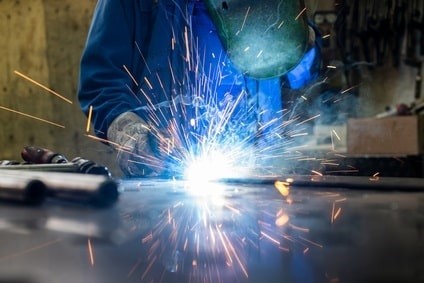Welding Joint Efficiency Tips for Trailer Builders (with Formula)


The fabrication of semi-trailers is an ever-evolving blend of skill, technology, and know-how. These steel chassis carry the largest cargo loads on roads and highways and current federal regulations for 49 CFR 393.201 apply to the frame of the tractor vehicle itself and not the semi-trailer. Manufacturers must ensure that their trailers are constructed safely and follow equipment manufacturer guidelines, including the ones outlined in ASME Maximum Allowable Joint Efficiencies for Arc and Gas Welded Joints. 
One of the most critical design elements of these trailers is welded joints. This is because these connector points are more susceptible to stress versus the main steel beams of the chassis due to the exposure of sharp angles during the fabrication process, and the potential for defects and residual stress from heat during welding.
Today’s manufacturing requirements demand fast and reliable welds with varying levels of automation. The technology used in welding includes complex physical characteristics that should be understood by your fabrication team; this includes residual stress, imperfections, and stress concentrations. These variables all have an impact on your final weld design and, when done correctly, allow you to achieve good fatigue resistance.
The following tips can help ensure proper joint efficiency to the highest quality standards in your operation:
To learn even more about welding joint efficiency, read on.
The heat input during welding can have a direct impact on the tensile strength and overall toughness of the welded joint. Many semi-trailers are fabricated using high strength grades of steel which can be sensitive to these factors. There are recommended guidelines for maximum heat input based on the base metal thickness and type of weld being performed.
The following equation is used to calculate heat input:
Heat Input (Q) = E*k where E = (U*I*60)/(v*1000) kj/mm*
[k = arc efficiency, U = voltage, I = current, and v = travel speed (mm/min)]
In general, for high impact and vulnerable welds, the maximum interpass temperature is 212°F, whereas it is possible to use higher heat outputs in low-stress areas.
There are several choices available for filler metal and simply matching the strength of the filler to that of the base alloy is a standard practice. Another consideration for trailer application, specifically, is that the locations of welds rarely experience a level of stress that requires a direct match to the base alloy. So, the possibility exists to utilize under-matched filler metal if the trailer manufacturer has a full understanding of the factors impacting the welds. Many builders utilize aluminum filler metal 5356 as it is easily obtained and useable with the 5XXX and 6XXX base aluminum found in trailer frame construction.
It is important for any operation to get its welds right the first time so as to best avoid unnecessary repairs in the future. A proper welding technique should achieve a smooth transition radius and a round angle at the weld joint. In addition, it’s necessary to have an adequate inspection process in place to locate the most common defects including:
The technique of inline weaving, also called “shuffling,” is very common in semi-trailer construction and is essentially done for appearance. This means that it does not have an impact on the vehicle’s weld efficiency when performed correctly. When this technique is applied, it is important that the width of the weaving be between 3-4 mm in amplitude, as anything larger could produce low spots within the weaving or reduce the length of weld throat.
Preheating of the underlying alloy to a temperature of 200°F is often done prior to welding as a means to remove moisture. In aluminum welding used in the trailer industry, however, there is little need for a full preheating treatment, (including aging, where the alloy is exposed to temperatures as high as 325-400°F). This level of preheating can have an adverse effect on the strength and mechanical properties of the alloy. Technicians must ensure that the aluminum being welded is cleaned properly but not overly processed.
These characteristics of the weld can all have a direct impact on the trailer’s overall joint efficiency post-fabrication. Thus, maintaining an awareness of these quality processes is a critical factor in achieving a proper trailer build.
Our sales engineers are experts in automatic asset tracking, tagging and identification,a nd can answer all your questions. Get in touch now.
Lets Talk ›